The cubic honeycomb or cubic cellulation is the only proper regular space-filling
tessellation
A tessellation or tiling is the covering of a surface, often a plane, using one or more geometric shapes, called ''tiles'', with no overlaps and no gaps. In mathematics, tessellation can be generalized to higher dimensions and a variety of ...
(or
honeycomb
A honeycomb is a mass of hexagonal prismatic wax cells built by honey bees in their nests to contain their larvae and stores of honey and pollen.
Beekeepers may remove the entire honeycomb to harvest honey. Honey bees consume about of honey ...
) in
Euclidean 3-space made up of
cubic cells. It has 4 cubes around every edge, and 8 cubes around each vertex. Its
vertex figure
In geometry, a vertex figure, broadly speaking, is the figure exposed when a corner of a polyhedron or polytope is sliced off.
Definitions
Take some corner or vertex of a polyhedron. Mark a point somewhere along each connected edge. Draw line ...
is a regular
octahedron
In geometry, an octahedron (plural: octahedra, octahedrons) is a polyhedron with eight faces. The term is most commonly used to refer to the regular octahedron, a Platonic solid composed of eight equilateral triangles, four of which meet at ea ...
. It is a
self-dual
In mathematics, a duality translates concepts, theorems or mathematical structures into other concepts, theorems or structures, in a one-to-one fashion, often (but not always) by means of an involution operation: if the dual of is , then the ...
tessellation with
Schläfli symbol
In geometry, the Schläfli symbol is a notation of the form \ that defines regular polytopes and tessellations.
The Schläfli symbol is named after the 19th-century Swiss mathematician Ludwig Schläfli, who generalized Euclidean geometry to mo ...
.
John Horton Conway
John Horton Conway (26 December 1937 – 11 April 2020) was an English mathematician active in the theory of finite groups, knot theory, number theory, combinatorial game theory and coding theory. He also made contributions to many branches ...
called this honeycomb a cubille.
Related honeycombs
It is part of a multidimensional family of
hypercube honeycomb
In geometry, a hypercubic honeycomb is a family of List of regular polytopes#Tessellations, regular honeycombs (tessellations) in -dimensional spaces with the Schläfli symbols and containing the symmetry of Coxeter diagram#Infinite Coxeter grou ...
s, with
Schläfli symbol
In geometry, the Schläfli symbol is a notation of the form \ that defines regular polytopes and tessellations.
The Schläfli symbol is named after the 19th-century Swiss mathematician Ludwig Schläfli, who generalized Euclidean geometry to mo ...
s of the form , starting with the
square tiling
In geometry, the square tiling, square tessellation or square grid is a regular tiling of the Euclidean plane. It has Schläfli symbol of meaning it has 4 squares around every vertex.
Conway called it a quadrille.
The internal angle of th ...
, in the plane.
It is one of 28
uniform honeycombs using
convex uniform polyhedral cells.
Isometries of simple cubic lattices
Simple cubic lattices can be distorted into lower symmetries, represented by lower crystal systems:
Uniform colorings
There is a large number of
uniform colorings, derived from different symmetries. These include:
Projections
The ''cubic honeycomb'' can be orthogonally projected into the euclidean plane with various symmetry arrangements. The highest (hexagonal) symmetry form projects into a
triangular tiling
In geometry, the triangular tiling or triangular tessellation is one of the three regular tilings of the Euclidean plane, and is the only such tiling where the constituent shapes are not parallelogons. Because the internal angle of the equilater ...
. A square symmetry projection forms a
square tiling
In geometry, the square tiling, square tessellation or square grid is a regular tiling of the Euclidean plane. It has Schläfli symbol of meaning it has 4 squares around every vertex.
Conway called it a quadrille.
The internal angle of th ...
.
Related polytopes and honeycombs
It is related to the regular
4-polytope tesseract
In geometry, a tesseract is the four-dimensional analogue of the cube; the tesseract is to the cube as the cube is to the square. Just as the surface of the cube consists of six square faces, the hypersurface of the tesseract consists of e ...
,
Schläfli symbol
In geometry, the Schläfli symbol is a notation of the form \ that defines regular polytopes and tessellations.
The Schläfli symbol is named after the 19th-century Swiss mathematician Ludwig Schläfli, who generalized Euclidean geometry to mo ...
, which exists in 4-space, and only has ''3'' cubes around each edge. It's also related to the
order-5 cubic honeycomb, Schläfli symbol , of
hyperbolic space with 5 cubes around each edge.
It is in a sequence of polychora and honeycombs with
octahedral vertex figure
In geometry, a vertex figure, broadly speaking, is the figure exposed when a corner of a polyhedron or polytope is sliced off.
Definitions
Take some corner or vertex of a polyhedron. Mark a point somewhere along each connected edge. Draw line ...
s.
It in a sequence of
regular polytopes
In mathematics, a regular polytope is a polytope whose symmetry group acts transitively on its flags, thus giving it the highest degree of symmetry. All its elements or -faces (for all , where is the dimension of the polytope) — cells, ...
and honeycombs with
cubic cells
Cell most often refers to:
* Cell (biology), the functional basic unit of life
Cell may also refer to:
Locations
* Monastic cell, a small room, hut, or cave in which a religious recluse lives, alternatively the small precursor of a monastery w ...
.
Related polytopes
The cubic honeycomb has a lower symmetry as a runcinated cubic honeycomb, with two sizes of
cube
In geometry, a cube is a three-dimensional solid object bounded by six square faces, facets or sides, with three meeting at each vertex. Viewed from a corner it is a hexagon and its net is usually depicted as a cross.
The cube is the only ...
s. A double symmetry construction can be constructed by placing a small cube into each large cube, resulting in a nonuniform honeycomb with
cube
In geometry, a cube is a three-dimensional solid object bounded by six square faces, facets or sides, with three meeting at each vertex. Viewed from a corner it is a hexagon and its net is usually depicted as a cross.
The cube is the only ...
s, square prisms, and rectangular trapezoprisms (a cube with ''D
2d'' symmetry). Its vertex figure is a triangular pyramid with its lateral faces augmented by tetrahedra.
 Dual cell
Dual cell
The resulting honeycomb can be alternated to produce another nonuniform honeycomb with regular
tetrahedra
In geometry, a tetrahedron (plural: tetrahedra or tetrahedrons), also known as a triangular pyramid, is a polyhedron composed of four triangular faces, six straight edges, and four vertex corners. The tetrahedron is the simplest of all th ...
, two kinds of tetragonal disphenoids, triangular pyramids, and sphenoids. Its vertex figure has ''C
3v'' symmetry and has 26 triangular faces, 39 edges, and 15 vertices.
Related Euclidean tessellations
The
,3,4 ,
Coxeter group generates 15 permutations of uniform tessellations, 9 with distinct geometry including the alternated cubic honeycomb. The
expanded cubic honeycomb (also known as the runcinated cubic honeycomb) is geometrically identical to the cubic honeycomb.
The
,31,1 ,
Coxeter group generates 9 permutations of uniform tessellations, 4 with distinct geometry including the alternated cubic honeycomb.
This honeycomb is one of
five distinct uniform honeycombs constructed by the
Coxeter group. The symmetry can be multiplied by the symmetry of rings in the
Coxeter–Dynkin diagram
In geometry, a Coxeter–Dynkin diagram (or Coxeter diagram, Coxeter graph) is a graph with numerically labeled edges (called branches) representing the spatial relations between a collection of mirrors (or reflecting hyperplanes). It describe ...
s:
----
Rectified cubic honeycomb
The rectified cubic honeycomb or rectified cubic cellulation is a uniform space-filling
tessellation
A tessellation or tiling is the covering of a surface, often a plane, using one or more geometric shapes, called ''tiles'', with no overlaps and no gaps. In mathematics, tessellation can be generalized to higher dimensions and a variety of ...
(or
honeycomb
A honeycomb is a mass of hexagonal prismatic wax cells built by honey bees in their nests to contain their larvae and stores of honey and pollen.
Beekeepers may remove the entire honeycomb to harvest honey. Honey bees consume about of honey ...
) in Euclidean 3-space. It is composed of
octahedra and
cuboctahedra
A cuboctahedron is a polyhedron with 8 triangular faces and 6 square faces. A cuboctahedron has 12 identical vertices, with 2 triangles and 2 squares meeting at each, and 24 identical edges, each separating a triangle from a square. As such, i ...
in a ratio of 1:1, with a
square prism vertex figure
In geometry, a vertex figure, broadly speaking, is the figure exposed when a corner of a polyhedron or polytope is sliced off.
Definitions
Take some corner or vertex of a polyhedron. Mark a point somewhere along each connected edge. Draw line ...
.
John Horton Conway
John Horton Conway (26 December 1937 – 11 April 2020) was an English mathematician active in the theory of finite groups, knot theory, number theory, combinatorial game theory and coding theory. He also made contributions to many branches ...
calls this honeycomb a cuboctahedrille, and its dual an
oblate octahedrille.

Projections
The ''rectified cubic honeycomb'' can be orthogonally projected into the euclidean plane with various symmetry arrangements.
Symmetry
There are four
uniform colorings for the cells of this honeycomb with reflective symmetry, listed by their
Coxeter group, and
Wythoff construction name, and the
Coxeter diagram
Harold Scott MacDonald "Donald" Coxeter, (9 February 1907 – 31 March 2003) was a British and later also Canadian geometer. He is regarded as one of the greatest geometers of the 20th century.
Biography
Coxeter was born in Kensington t ...
below.
This honeycomb can be divided on
trihexagonal tiling
In geometry, the trihexagonal tiling is one of 11 uniform tilings of the Euclidean plane by regular polygons. See in particular Theorem 2.1.3, p. 59 (classification of uniform tilings); Figure 2.1.5, p.63 (illustration of this tiling), Theorem 2 ...
planes, using the
hexagon
In geometry, a hexagon (from Greek , , meaning "six", and , , meaning "corner, angle") is a six-sided polygon. The total of the internal angles of any simple (non-self-intersecting) hexagon is 720°.
Regular hexagon
A '' regular hexagon'' has ...
centers of the cuboctahedra, creating two
triangular cupola
In geometry, the triangular cupola is one of the Johnson solids (). It can be seen as half a cuboctahedron.
Formulae
The following formulae for the volume (V), the surface area (A) and the height (H) can be used if all faces are regular, ...
e. This
scaliform honeycomb is represented by Coxeter diagram , and symbol s
3, with
coxeter notation
In geometry, Coxeter notation (also Coxeter symbol) is a system of classifying symmetry groups, describing the angles between fundamental reflections of a Coxeter group in a bracketed notation expressing the structure of a Coxeter-Dynkin diagra ...
symmetry
+,6,3
:

.
Related polytopes
A double symmetry construction can be made by placing octahedra on the cuboctahedra, resulting in a nonuniform honeycomb with two kinds of
octahedra (regular octahedra and triangular antiprisms). The vertex figure is a
square bifrustum
The square bifrustum or ''square truncated bipyramid'' is the second in an infinite series of bifrustum polyhedra. It has 4 trapezoidal and 2 square faces.
This polyhedron can be constructed by taking a square bipyramid (octahedron) and trunca ...
. The dual is composed of
elongated square bipyramid
In geometry, the elongated square bipyramid (or elongated octahedron) is one of the Johnson solids (). As the name suggests, it can be constructed by elongating an octahedron by inserting a cube between its congruent halves.
It has been named ...
s.
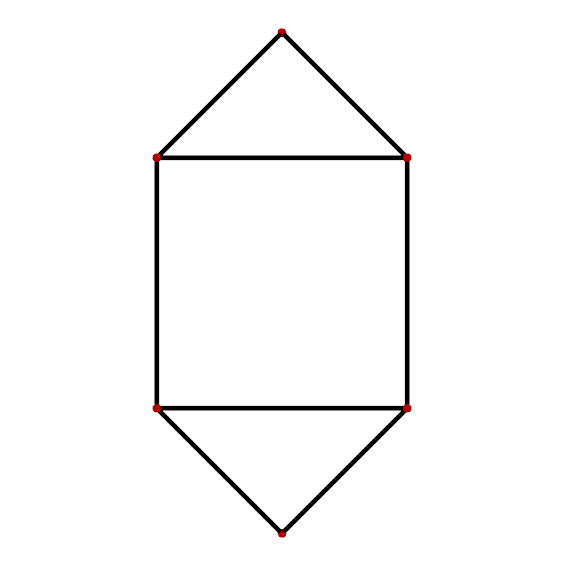 Dual cell
Dual cell
----
Truncated cubic honeycomb
The truncated cubic honeycomb or truncated cubic cellulation is a uniform space-filling
tessellation
A tessellation or tiling is the covering of a surface, often a plane, using one or more geometric shapes, called ''tiles'', with no overlaps and no gaps. In mathematics, tessellation can be generalized to higher dimensions and a variety of ...
(or
honeycomb
A honeycomb is a mass of hexagonal prismatic wax cells built by honey bees in their nests to contain their larvae and stores of honey and pollen.
Beekeepers may remove the entire honeycomb to harvest honey. Honey bees consume about of honey ...
) in Euclidean 3-space. It is composed of
truncated cubes and
octahedra in a ratio of 1:1, with an isosceles
square pyramid
In geometry, a square pyramid is a pyramid having a square base. If the apex is perpendicularly above the center of the square, it is a right square pyramid, and has symmetry. If all edge lengths are equal, it is an equilateral square pyrami ...
vertex figure
In geometry, a vertex figure, broadly speaking, is the figure exposed when a corner of a polyhedron or polytope is sliced off.
Definitions
Take some corner or vertex of a polyhedron. Mark a point somewhere along each connected edge. Draw line ...
.
John Horton Conway
John Horton Conway (26 December 1937 – 11 April 2020) was an English mathematician active in the theory of finite groups, knot theory, number theory, combinatorial game theory and coding theory. He also made contributions to many branches ...
calls this honeycomb a truncated cubille, and its dual
pyramidille
The tetragonal disphenoid tetrahedral honeycomb is a space-filling tessellation (or honeycomb) in Euclidean 3-space made up of identical tetragonal disphenoidal cells. Cells are face-transitive with 4 identical isosceles triangle faces. John H ...
.

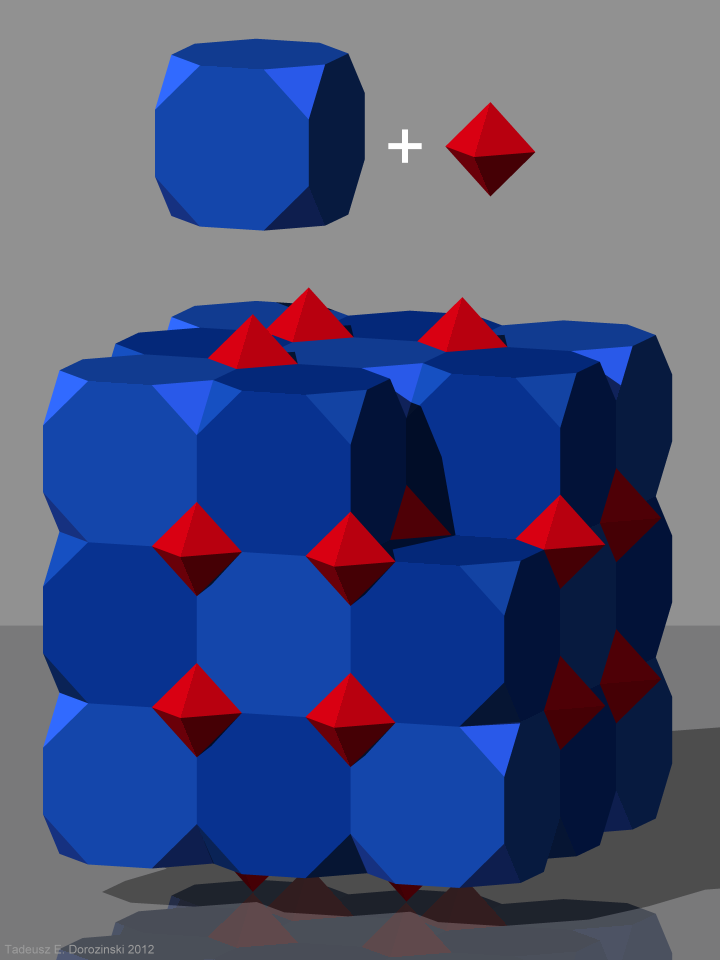
Projections
The ''truncated cubic honeycomb'' can be orthogonally projected into the euclidean plane with various symmetry arrangements.
Symmetry
There is a second
uniform coloring by reflectional symmetry of the
Coxeter groups, the second seen with alternately colored truncated cubic cells.
Related polytopes
A double symmetry construction can be made by placing octahedra on the truncated cubes, resulting in a nonuniform honeycomb with two kinds of
octahedra (regular octahedra and triangular antiprisms) and two kinds of
tetrahedra
In geometry, a tetrahedron (plural: tetrahedra or tetrahedrons), also known as a triangular pyramid, is a polyhedron composed of four triangular faces, six straight edges, and four vertex corners. The tetrahedron is the simplest of all th ...
(tetragonal disphenoids and digonal disphenoids). The vertex figure is an octakis square cupola.

Vertex figure
In geometry, a vertex figure, broadly speaking, is the figure exposed when a corner of a polyhedron or polytope is sliced off.
Definitions
Take some corner or vertex of a polyhedron. Mark a point somewhere along each connected edge. Draw line ...
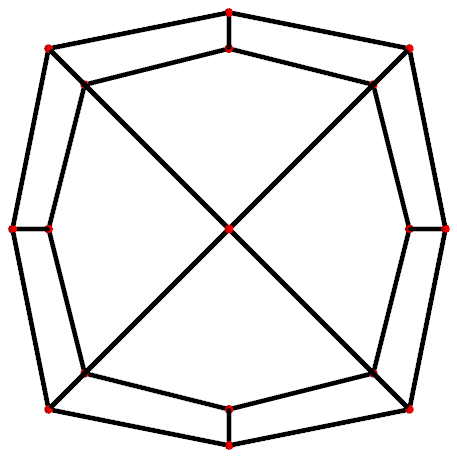 Dual cell
Dual cell
----
Bitruncated cubic honeycomb

The bitruncated cubic honeycomb is a space-filling
tessellation
A tessellation or tiling is the covering of a surface, often a plane, using one or more geometric shapes, called ''tiles'', with no overlaps and no gaps. In mathematics, tessellation can be generalized to higher dimensions and a variety of ...
(or
honeycomb
A honeycomb is a mass of hexagonal prismatic wax cells built by honey bees in their nests to contain their larvae and stores of honey and pollen.
Beekeepers may remove the entire honeycomb to harvest honey. Honey bees consume about of honey ...
) in
Euclidean 3-space made up of
truncated octahedra (or, equivalently,
bitruncated
In geometry, a bitruncation is an operation on regular polytopes. It represents a truncation beyond rectification. The original edges are lost completely and the original faces remain as smaller copies of themselves.
Bitruncated regular polyt ...
cubes). It has four
truncated octahedra around each vertex, in a
tetragonal disphenoid vertex figure
In geometry, a vertex figure, broadly speaking, is the figure exposed when a corner of a polyhedron or polytope is sliced off.
Definitions
Take some corner or vertex of a polyhedron. Mark a point somewhere along each connected edge. Draw line ...
. Being composed entirely of
truncated octahedra, it is
cell-transitive. It is also
edge-transitive
In geometry, a polytope (for example, a polygon or a polyhedron) or a tiling is isotoxal () or edge-transitive if its symmetries act transitively on its edges. Informally, this means that there is only one type of edge to the object: given t ...
, with 2 hexagons and one square on each edge, and
vertex-transitive
In geometry, a polytope (e.g. a polygon or polyhedron) or a tiling is isogonal or vertex-transitive if all its vertices are equivalent under the symmetries of the figure. This implies that each vertex is surrounded by the same kinds of fa ...
. It is one of 28
uniform honeycombs.
John Horton Conway
John Horton Conway (26 December 1937 – 11 April 2020) was an English mathematician active in the theory of finite groups, knot theory, number theory, combinatorial game theory and coding theory. He also made contributions to many branches ...
calls this honeycomb a truncated octahedrille in his
Architectonic and catoptric tessellation
In geometry, John Horton Conway defines architectonic and catoptric tessellations as the uniform tessellations (or honeycombs) of Euclidean 3-space with prime space groups and their duals, as three-dimensional analogue of the Platonic, Archime ...
list, with its dual called an ''oblate tetrahedrille'', also called a
disphenoid tetrahedral honeycomb
The tetragonal disphenoid tetrahedral honeycomb is a space-filling tessellation (or honeycomb) in Euclidean 3-space made up of identical tetragonal disphenoidal cells. Cells are face-transitive with 4 identical isosceles triangle faces. John Horton ...
. Although a regular
tetrahedron
In geometry, a tetrahedron (plural: tetrahedra or tetrahedrons), also known as a triangular pyramid, is a polyhedron composed of four triangular faces, six straight edges, and four vertex corners. The tetrahedron is the simplest of all ...
can not tessellate space alone, this dual has identical
disphenoid tetrahedron cells with
isosceles triangle
In geometry, an isosceles triangle () is a triangle that has two sides of equal length. Sometimes it is specified as having ''exactly'' two sides of equal length, and sometimes as having ''at least'' two sides of equal length, the latter versio ...
faces.
Projections
The ''bitruncated cubic honeycomb'' can be orthogonally projected into the euclidean plane with various symmetry arrangements. The highest (hexagonal) symmetry form projects into a nonuniform
rhombitrihexagonal tiling
In geometry, the rhombitrihexagonal tiling is a semiregular tiling of the Euclidean plane. There are one triangle, two squares, and one hexagon on each vertex. It has Schläfli symbol of rr.
John Conway calls it a rhombihexadeltille.Conway, ...
. A square symmetry projection forms two overlapping
truncated square tiling, which combine together as a
chamfered square tiling
In geometry, the chamfered square tiling or semitruncated square tiling is a tiling of the Euclidean plane. It is a square tiling with each edge Chamfer (geometry), chamfered into new hexagonal faces.
It can also be seen as the intersection of tw ...
.
Symmetry
The vertex figure for this honeycomb is a
disphenoid tetrahedron, and it is also the
Goursat tetrahedron (
fundamental domain
Given a topological space and a group acting on it, the images of a single point under the group action form an orbit of the action. A fundamental domain or fundamental region is a subset of the space which contains exactly one point from each o ...
) for the
Coxeter group. This honeycomb has four uniform constructions, with the truncated octahedral cells having different
Coxeter groups and
Wythoff constructions. These uniform symmetries can be represented by coloring differently the cells in each construction.
Related polytopes
Nonuniform variants with
,3,4symmetry and two types of truncated octahedra can be doubled by placing the two types of truncated octahedra to produce a nonuniform honeycomb with
truncated octahedra and
hexagonal prisms (as ditrigonal trapezoprisms). Its vertex figure is a ''C
2v''-symmetric
triangular bipyramid
In geometry, the triangular bipyramid (or dipyramid) is a type of hexahedron, being the first in the infinite set of face-transitive bipyramids. It is the dual of the triangular prism with 6 isosceles triangle faces.
As the name suggests, ...
.
This honeycomb can then be alternated to produce another nonuniform honeycomb with
pyritohedral icosahedra,
octahedra (as triangular antiprisms), and
tetrahedra
In geometry, a tetrahedron (plural: tetrahedra or tetrahedrons), also known as a triangular pyramid, is a polyhedron composed of four triangular faces, six straight edges, and four vertex corners. The tetrahedron is the simplest of all th ...
(as sphenoids). Its vertex figure has ''C
2v'' symmetry and consists of 2
pentagon
In geometry, a pentagon (from the Greek πέντε ''pente'' meaning ''five'' and γωνία ''gonia'' meaning ''angle'') is any five-sided polygon or 5-gon. The sum of the internal angles in a simple pentagon is 540°.
A pentagon may be sim ...
s, 4
rectangle
In Euclidean plane geometry, a rectangle is a quadrilateral with four right angles. It can also be defined as: an equiangular quadrilateral, since equiangular means that all of its angles are equal (360°/4 = 90°); or a parallelogram contain ...
s, 4
isosceles triangle
In geometry, an isosceles triangle () is a triangle that has two sides of equal length. Sometimes it is specified as having ''exactly'' two sides of equal length, and sometimes as having ''at least'' two sides of equal length, the latter versio ...
s (divided into two sets of 2), and 4
scalene triangle
A triangle is a polygon with three edges and three vertices. It is one of the basic shapes in geometry. A triangle with vertices ''A'', ''B'', and ''C'' is denoted \triangle ABC.
In Euclidean geometry, any three points, when non-collin ...
s.
----
Alternated bitruncated cubic honeycomb
The alternated bitruncated cubic honeycomb or bisnub cubic honeycomb is non-uniform, with the highest symmetry construction reflecting an alternation of the uniform bitruncated cubic honeycomb. A lower-symmetry construction involves regular icosahedra paired with golden icosahedra (with 8 equilateral triangles paired with 12 golden triangles). There are three constructions from three related
Coxeter diagram
Harold Scott MacDonald "Donald" Coxeter, (9 February 1907 – 31 March 2003) was a British and later also Canadian geometer. He is regarded as one of the greatest geometers of the 20th century.
Biography
Coxeter was born in Kensington t ...
s: , , and . These have symmetry
,3+,4 ,(31,1)+and
[4/sup>.html" ;"title=".html" ;"title="
[4">[4/sup>">.html" ;"title="[4">[4/sup>sup>+ respectively. The first and last symmetry can be doubled as 4,3+,4 and [ [4/sup>+.
This honeycomb is represented in the boron atoms of the Allotropes of boron#.CE.B1-rhombohedral boron, α-rhombihedral crystal. The centers of the icosahedra are located at the fcc positions of the lattice.
----
Cantellated cubic honeycomb
The cantellated cubic honeycomb or cantellated cubic cellulation is a uniform space-filling tessellation
A tessellation or tiling is the covering of a surface, often a plane, using one or more geometric shapes, called ''tiles'', with no overlaps and no gaps. In mathematics, tessellation can be generalized to higher dimensions and a variety of ...
(or honeycomb
A honeycomb is a mass of hexagonal prismatic wax cells built by honey bees in their nests to contain their larvae and stores of honey and pollen.
Beekeepers may remove the entire honeycomb to harvest honey. Honey bees consume about of honey ...
) in Euclidean 3-space. It is composed of rhombicuboctahedron, rhombicuboctahedra, cuboctahedra
A cuboctahedron is a polyhedron with 8 triangular faces and 6 square faces. A cuboctahedron has 12 identical vertices, with 2 triangles and 2 squares meeting at each, and 24 identical edges, each separating a triangle from a square. As such, i ...
, and cube
In geometry, a cube is a three-dimensional solid object bounded by six square faces, facets or sides, with three meeting at each vertex. Viewed from a corner it is a hexagon and its net is usually depicted as a cross.
The cube is the only ...
s in a ratio of 1:1:3, with a wedge vertex figure
In geometry, a vertex figure, broadly speaking, is the figure exposed when a corner of a polyhedron or polytope is sliced off.
Definitions
Take some corner or vertex of a polyhedron. Mark a point somewhere along each connected edge. Draw line ...
.
John Horton Conway
John Horton Conway (26 December 1937 – 11 April 2020) was an English mathematician active in the theory of finite groups, knot theory, number theory, combinatorial game theory and coding theory. He also made contributions to many branches ...
calls this honeycomb a 2-RCO-trille, and its dual quarter oblate octahedrille.
:

Images
Projections
The ''cantellated cubic honeycomb'' can be orthogonally projected into the euclidean plane with various symmetry arrangements.
Symmetry
There is a second uniform colorings by reflectional symmetry of the Coxeter groups, the second seen with alternately colored rhombicuboctahedral cells.
Related polytopes
A double symmetry construction can be made by placing cuboctahedra on the rhombicuboctahedra, which results in the rectified cubic honeycomb, by taking the triangular antiprism gaps as regular octahedra, square antiprism pairs and zero-height tetragonal disphenoids as components of the cuboctahedron. Other variants result in cuboctahedra
A cuboctahedron is a polyhedron with 8 triangular faces and 6 square faces. A cuboctahedron has 12 identical vertices, with 2 triangles and 2 squares meeting at each, and 24 identical edges, each separating a triangle from a square. As such, i ...
, square antiprisms, octahedra (as triangular antipodiums), and tetrahedra
In geometry, a tetrahedron (plural: tetrahedra or tetrahedrons), also known as a triangular pyramid, is a polyhedron composed of four triangular faces, six straight edges, and four vertex corners. The tetrahedron is the simplest of all th ...
(as tetragonal disphenoids), with a vertex figure topologically equivalent to a cube
In geometry, a cube is a three-dimensional solid object bounded by six square faces, facets or sides, with three meeting at each vertex. Viewed from a corner it is a hexagon and its net is usually depicted as a cross.
The cube is the only ...
with a triangular prism
In geometry, a triangular prism is a three-sided prism; it is a polyhedron made of a triangular base, a translated copy, and 3 faces joining corresponding sides. A right triangular prism has rectangular sides, otherwise it is ''oblique''. A ...
attached to one of its square faces.
----
Quarter oblate octahedrille
The dual of the ''cantellated cubic honeycomb'' is called a quarter oblate octahedrille, a catoptric tessellation with Coxeter diagram
Harold Scott MacDonald "Donald" Coxeter, (9 February 1907 – 31 March 2003) was a British and later also Canadian geometer. He is regarded as one of the greatest geometers of the 20th century.
Biography
Coxeter was born in Kensington t ...
, containing faces from two of four hyperplanes of the cubic ,3,4fundamental domain.
It has irregular triangle bipyramid cells which can be seen as 1/12 of a cube, made from the cube center, 2 face centers, and 2 vertices.
: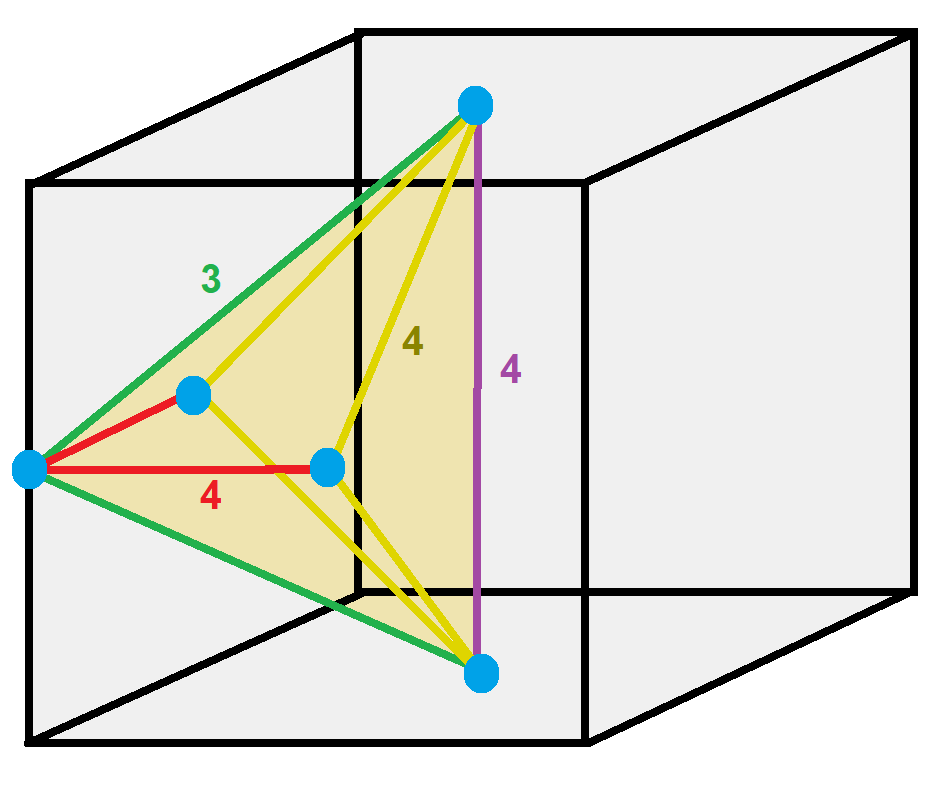
Cantitruncated cubic honeycomb
The cantitruncated cubic honeycomb or cantitruncated cubic cellulation is a uniform space-filling tessellation
A tessellation or tiling is the covering of a surface, often a plane, using one or more geometric shapes, called ''tiles'', with no overlaps and no gaps. In mathematics, tessellation can be generalized to higher dimensions and a variety of ...
(or honeycomb
A honeycomb is a mass of hexagonal prismatic wax cells built by honey bees in their nests to contain their larvae and stores of honey and pollen.
Beekeepers may remove the entire honeycomb to harvest honey. Honey bees consume about of honey ...
) in Euclidean 3-space, made up of truncated cuboctahedra, truncated octahedra, and cube
In geometry, a cube is a three-dimensional solid object bounded by six square faces, facets or sides, with three meeting at each vertex. Viewed from a corner it is a hexagon and its net is usually depicted as a cross.
The cube is the only ...
s in a ratio of 1:1:3, with a mirrored sphenoid
In geometry, a tetrahedron (plural: tetrahedra or tetrahedrons), also known as a triangular pyramid, is a polyhedron composed of four triangular faces, six straight edges, and four vertex corners. The tetrahedron is the simplest of all the ...
vertex figure
In geometry, a vertex figure, broadly speaking, is the figure exposed when a corner of a polyhedron or polytope is sliced off.
Definitions
Take some corner or vertex of a polyhedron. Mark a point somewhere along each connected edge. Draw line ...
.
John Horton Conway
John Horton Conway (26 December 1937 – 11 April 2020) was an English mathematician active in the theory of finite groups, knot theory, number theory, combinatorial game theory and coding theory. He also made contributions to many branches ...
calls this honeycomb a n-tCO-trille, and its dual triangular pyramidille.
: 
Images
Four cells exist around each vertex:
:
Projections
The ''cantitruncated cubic honeycomb'' can be orthogonally projected into the euclidean plane with various symmetry arrangements.
Symmetry
Cells can be shown in two different symmetries. The linear Coxeter diagram
Harold Scott MacDonald "Donald" Coxeter, (9 February 1907 – 31 March 2003) was a British and later also Canadian geometer. He is regarded as one of the greatest geometers of the 20th century.
Biography
Coxeter was born in Kensington t ...
form can be drawn with one color for each cell type. The bifurcating diagram form can be drawn with two types (colors) of truncated cuboctahedron
In geometry, the truncated cuboctahedron is an Archimedean solid, named by Kepler as a truncation of a cuboctahedron. It has 12 square faces, 8 regular hexagonal faces, 6 regular octagonal faces, 48 vertices, and 72 edges. Since each of its fa ...
cells alternating.
Triangular pyramidille
The dual of the ''cantitruncated cubic honeycomb'' is called a triangular pyramidille, with Coxeter diagram
Harold Scott MacDonald "Donald" Coxeter, (9 February 1907 – 31 March 2003) was a British and later also Canadian geometer. He is regarded as one of the greatest geometers of the 20th century.
Biography
Coxeter was born in Kensington t ...
, . This honeycomb cells represents the fundamental domains of symmetry.
A cell can be as 1/24 of a translational cube with vertices positioned: taking two corner, ne face center, and the cube center. The edge colors and labels specify how many cells exist around the edge.
: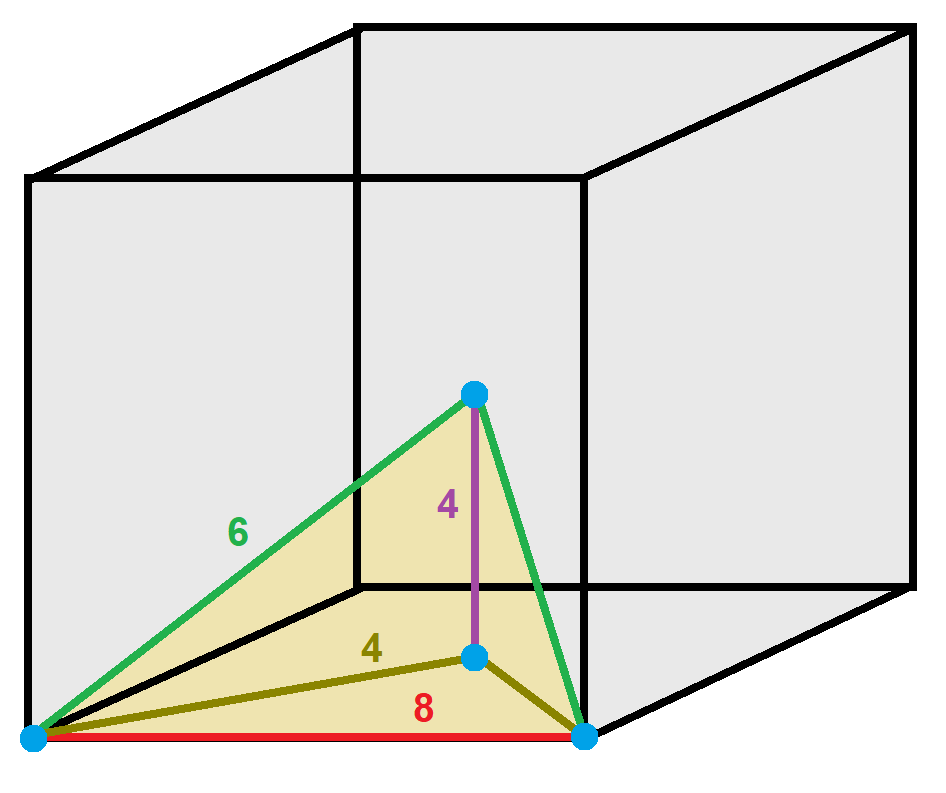
Related polyhedra and honeycombs
It is related to a skew apeirohedron with vertex configuration 4.4.6.6, with the octagons and some of the squares removed. It can be seen as constructed by augmenting truncated cuboctahedral cells, or by augmenting alternated truncated octahedra and cubes.
Related polytopes
A double symmetry construction can be made by placing truncated octahedra on the truncated cuboctahedra, resulting in a nonuniform honeycomb with truncated octahedra, hexagonal prisms (as ditrigonal trapezoprisms), cube
In geometry, a cube is a three-dimensional solid object bounded by six square faces, facets or sides, with three meeting at each vertex. Viewed from a corner it is a hexagon and its net is usually depicted as a cross.
The cube is the only ...
s (as square prisms), triangular prism
In geometry, a triangular prism is a three-sided prism; it is a polyhedron made of a triangular base, a translated copy, and 3 faces joining corresponding sides. A right triangular prism has rectangular sides, otherwise it is ''oblique''. A ...
s (as ''C2v''-symmetric wedges), and tetrahedra
In geometry, a tetrahedron (plural: tetrahedra or tetrahedrons), also known as a triangular pyramid, is a polyhedron composed of four triangular faces, six straight edges, and four vertex corners. The tetrahedron is the simplest of all th ...
(as tetragonal disphenoids). Its vertex figure is topologically equivalent to the octahedron
In geometry, an octahedron (plural: octahedra, octahedrons) is a polyhedron with eight faces. The term is most commonly used to refer to the regular octahedron, a Platonic solid composed of eight equilateral triangles, four of which meet at ea ...
.
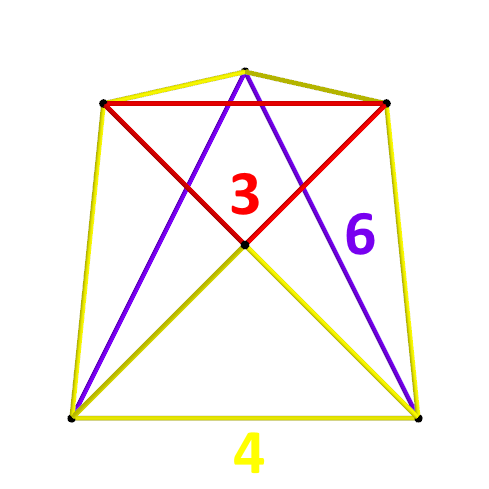
Vertex figure
In geometry, a vertex figure, broadly speaking, is the figure exposed when a corner of a polyhedron or polytope is sliced off.
Definitions
Take some corner or vertex of a polyhedron. Mark a point somewhere along each connected edge. Draw line ...

Dual cell
----
Alternated cantitruncated cubic honeycomb
The alternated cantitruncated cubic honeycomb or snub rectified cubic honeycomb contains three types of cells: snub cubes, icosahedra
In geometry, an icosahedron ( or ) is a polyhedron with 20 faces. The name comes and . The plural can be either "icosahedra" () or "icosahedrons".
There are infinitely many non- similar shapes of icosahedra, some of them being more symmetrica ...
(with ''Th'' symmetry), tetrahedra
In geometry, a tetrahedron (plural: tetrahedra or tetrahedrons), also known as a triangular pyramid, is a polyhedron composed of four triangular faces, six straight edges, and four vertex corners. The tetrahedron is the simplest of all th ...
(as tetragonal disphenoids), and new tetrahedral cells created at the gaps.
Although it is not uniform, constructionally it can be given as Coxeter diagram
Harold Scott MacDonald "Donald" Coxeter, (9 February 1907 – 31 March 2003) was a British and later also Canadian geometer. He is regarded as one of the greatest geometers of the 20th century.
Biography
Coxeter was born in Kensington t ...
s or .
Despite being non-uniform, there is a near-miss version with two edge lengths shown below, one of which is around 4.3% greater than the other. The snub cubes in this case are uniform, but the rest of the cells are not.
----
Cantic snub cubic honeycomb
The cantic snub cubic honeycomb is constructed by snubbing the truncated octahedra in a way that leaves only rectangle
In Euclidean plane geometry, a rectangle is a quadrilateral with four right angles. It can also be defined as: an equiangular quadrilateral, since equiangular means that all of its angles are equal (360°/4 = 90°); or a parallelogram contain ...
s from the cube
In geometry, a cube is a three-dimensional solid object bounded by six square faces, facets or sides, with three meeting at each vertex. Viewed from a corner it is a hexagon and its net is usually depicted as a cross.
The cube is the only ...
s (square prisms). It is not uniform but it can be represented as Coxeter diagram
Harold Scott MacDonald "Donald" Coxeter, (9 February 1907 – 31 March 2003) was a British and later also Canadian geometer. He is regarded as one of the greatest geometers of the 20th century.
Biography
Coxeter was born in Kensington t ...
. It has rhombicuboctahedron, rhombicuboctahedra (with ''Th'' symmetry), icosahedra
In geometry, an icosahedron ( or ) is a polyhedron with 20 faces. The name comes and . The plural can be either "icosahedra" () or "icosahedrons".
There are infinitely many non- similar shapes of icosahedra, some of them being more symmetrica ...
(with ''Th'' symmetry), and triangular prism
In geometry, a triangular prism is a three-sided prism; it is a polyhedron made of a triangular base, a translated copy, and 3 faces joining corresponding sides. A right triangular prism has rectangular sides, otherwise it is ''oblique''. A ...
s (as ''C2v''-symmetry wedges) filling the gaps.cantic snub cubic honeycomb
/ref>
Related polytopes
A double symmetry construction can be made by placing icosahedra on the rhombicuboctahedra, resulting in a nonuniform honeycomb with icosahedra
In geometry, an icosahedron ( or ) is a polyhedron with 20 faces. The name comes and . The plural can be either "icosahedra" () or "icosahedrons".
There are infinitely many non- similar shapes of icosahedra, some of them being more symmetrica ...
, octahedra (as triangular antiprisms), triangular prism
In geometry, a triangular prism is a three-sided prism; it is a polyhedron made of a triangular base, a translated copy, and 3 faces joining corresponding sides. A right triangular prism has rectangular sides, otherwise it is ''oblique''. A ...
s (as ''C2v''-symmetric wedges), and square pyramid
In geometry, a square pyramid is a pyramid having a square base. If the apex is perpendicularly above the center of the square, it is a right square pyramid, and has symmetry. If all edge lengths are equal, it is an equilateral square pyrami ...
s.

Vertex figure
In geometry, a vertex figure, broadly speaking, is the figure exposed when a corner of a polyhedron or polytope is sliced off.
Definitions
Take some corner or vertex of a polyhedron. Mark a point somewhere along each connected edge. Draw line ...
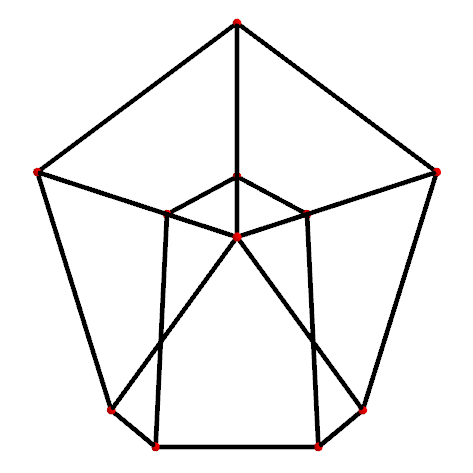
Dual cell
----
Runcitruncated cubic honeycomb
The runcitruncated cubic honeycomb or runcitruncated cubic cellulation is a uniform space-filling tessellation (or honeycomb
A honeycomb is a mass of hexagonal prismatic wax cells built by honey bees in their nests to contain their larvae and stores of honey and pollen.
Beekeepers may remove the entire honeycomb to harvest honey. Honey bees consume about of honey ...
) in Euclidean 3-space. It is composed of rhombicuboctahedron, rhombicuboctahedra, truncated cubes, octagonal prism
In geometry, the octagonal prism is the sixth in an infinite set of prisms, formed by rectangular sides and two regular octagon caps.
If faces are all regular, it is a semiregular polyhedron.
Symmetry
Images
The octagonal prism can also ...
s, and cube
In geometry, a cube is a three-dimensional solid object bounded by six square faces, facets or sides, with three meeting at each vertex. Viewed from a corner it is a hexagon and its net is usually depicted as a cross.
The cube is the only ...
s in a ratio of 1:1:3:3, with an isosceles-trapezoidal pyramid
A pyramid (from el, πυραμίς ') is a structure whose outer surfaces are triangular and converge to a single step at the top, making the shape roughly a pyramid in the geometric sense. The base of a pyramid can be trilateral, quadrilate ...
vertex figure
In geometry, a vertex figure, broadly speaking, is the figure exposed when a corner of a polyhedron or polytope is sliced off.
Definitions
Take some corner or vertex of a polyhedron. Mark a point somewhere along each connected edge. Draw line ...
.
Its name is derived from its Coxeter diagram
Harold Scott MacDonald "Donald" Coxeter, (9 February 1907 – 31 March 2003) was a British and later also Canadian geometer. He is regarded as one of the greatest geometers of the 20th century.
Biography
Coxeter was born in Kensington t ...
, with three ringed nodes representing 3 active mirrors in the Wythoff construction from its relation to the regular cubic honeycomb.
John Horton Conway
John Horton Conway (26 December 1937 – 11 April 2020) was an English mathematician active in the theory of finite groups, knot theory, number theory, combinatorial game theory and coding theory. He also made contributions to many branches ...
calls this honeycomb a 1-RCO-trille, and its dual square quarter pyramidille.


Projections
The ''runcitruncated cubic honeycomb'' can be orthogonally projected into the euclidean plane with various symmetry arrangements.
Related skew apeirohedron
Two related uniform skew apeirohedrons exists with the same vertex arrangement
In geometry, a vertex arrangement is a set of points in space described by their relative positions. They can be described by their use in polytopes.
For example, a ''square vertex arrangement'' is understood to mean four points in a plane, equa ...
, seen as boundary cells from a subset of cells. One has triangles and squares, and the other triangles, squares, and octagons.
:

Square quarter pyramidille
The dual to the ''runcitruncated cubic honeycomb'' is called a square quarter pyramidille, with Coxeter diagram
Harold Scott MacDonald "Donald" Coxeter, (9 February 1907 – 31 March 2003) was a British and later also Canadian geometer. He is regarded as one of the greatest geometers of the 20th century.
Biography
Coxeter was born in Kensington t ...
. Faces exist in 3 of 4 hyperplanes of the ,3,4 Coxeter group.
Cells are irregular pyramids and can be seen as 1/24 of a cube, using one corner, one mid-edge point, two face centers, and the cube center.
:
Related polytopes
A double symmetry construction can be made by placing rhombicuboctahedra on the truncated cubes, resulting in a nonuniform honeycomb with rhombicuboctahedron, rhombicuboctahedra, octahedra (as triangular antiprisms), cube
In geometry, a cube is a three-dimensional solid object bounded by six square faces, facets or sides, with three meeting at each vertex. Viewed from a corner it is a hexagon and its net is usually depicted as a cross.
The cube is the only ...
s (as square prisms), two kinds of triangular prism
In geometry, a triangular prism is a three-sided prism; it is a polyhedron made of a triangular base, a translated copy, and 3 faces joining corresponding sides. A right triangular prism has rectangular sides, otherwise it is ''oblique''. A ...
s (both ''C2v''-symmetric wedges), and tetrahedra
In geometry, a tetrahedron (plural: tetrahedra or tetrahedrons), also known as a triangular pyramid, is a polyhedron composed of four triangular faces, six straight edges, and four vertex corners. The tetrahedron is the simplest of all th ...
(as digonal disphenoids). Its vertex figure is topologically equivalent to the augmented triangular prism
In geometry, the augmented triangular prism is one of the Johnson solids (). As the name suggests, it can be constructed by augmenting a triangular prism by attaching a square pyramid () to one of its equatorial faces. The resulting solid bears ...
.

Vertex figure
In geometry, a vertex figure, broadly speaking, is the figure exposed when a corner of a polyhedron or polytope is sliced off.
Definitions
Take some corner or vertex of a polyhedron. Mark a point somewhere along each connected edge. Draw line ...
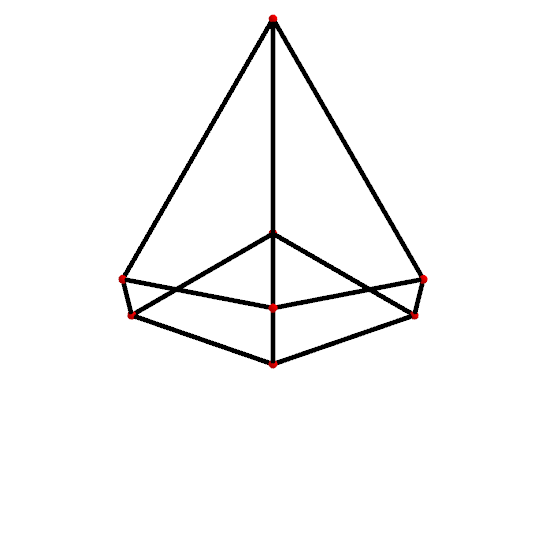
Dual cell
----
Omnitruncated cubic honeycomb
The omnitruncated cubic honeycomb or omnitruncated cubic cellulation is a uniform space-filling tessellation
A tessellation or tiling is the covering of a surface, often a plane, using one or more geometric shapes, called ''tiles'', with no overlaps and no gaps. In mathematics, tessellation can be generalized to higher dimensions and a variety of ...
(or honeycomb
A honeycomb is a mass of hexagonal prismatic wax cells built by honey bees in their nests to contain their larvae and stores of honey and pollen.
Beekeepers may remove the entire honeycomb to harvest honey. Honey bees consume about of honey ...
) in Euclidean 3-space. It is composed of truncated cuboctahedra and octagonal prism
In geometry, the octagonal prism is the sixth in an infinite set of prisms, formed by rectangular sides and two regular octagon caps.
If faces are all regular, it is a semiregular polyhedron.
Symmetry
Images
The octagonal prism can also ...
s in a ratio of 1:3, with a phyllic disphenoid vertex figure
In geometry, a vertex figure, broadly speaking, is the figure exposed when a corner of a polyhedron or polytope is sliced off.
Definitions
Take some corner or vertex of a polyhedron. Mark a point somewhere along each connected edge. Draw line ...
.
John Horton Conway
John Horton Conway (26 December 1937 – 11 April 2020) was an English mathematician active in the theory of finite groups, knot theory, number theory, combinatorial game theory and coding theory. He also made contributions to many branches ...
calls this honeycomb a b-tCO-trille, and its dual eighth pyramidille.
: 
Projections
The ''omnitruncated cubic honeycomb'' can be orthogonally projected into the euclidean plane with various symmetry arrangements.
Symmetry
Cells can be shown in two different symmetries. The Coxeter diagram
Harold Scott MacDonald "Donald" Coxeter, (9 February 1907 – 31 March 2003) was a British and later also Canadian geometer. He is regarded as one of the greatest geometers of the 20th century.
Biography
Coxeter was born in Kensington t ...
form has two colors of truncated cuboctahedra and octagonal prism
In geometry, the octagonal prism is the sixth in an infinite set of prisms, formed by rectangular sides and two regular octagon caps.
If faces are all regular, it is a semiregular polyhedron.
Symmetry
Images
The octagonal prism can also ...
s. The symmetry can be doubled by relating the first and last branches of the Coxeter diagram, which can be shown with one color for all the truncated cuboctahedral and octagonal prism cells.
Related polyhedra
Two related uniform skew apeirohedron exist with the same vertex arrangement
In geometry, a vertex arrangement is a set of points in space described by their relative positions. They can be described by their use in polytopes.
For example, a ''square vertex arrangement'' is understood to mean four points in a plane, equa ...
. The first has octagons removed, and vertex configuration 4.4.4.6. It can be seen as truncated cuboctahedra and octagonal prisms augmented together. The second can be seen as augmented octagonal prisms, vertex configuration 4.8.4.8.
Related polytopes
Nonuniform variants with ,3,4symmetry and two types of truncated cuboctahedra can be doubled by placing the two types of truncated cuboctahedra on each other to produce a nonuniform honeycomb with truncated cuboctahedra, octagonal prism
In geometry, the octagonal prism is the sixth in an infinite set of prisms, formed by rectangular sides and two regular octagon caps.
If faces are all regular, it is a semiregular polyhedron.
Symmetry
Images
The octagonal prism can also ...
s, hexagonal prisms (as ditrigonal trapezoprisms), and two kinds of cube
In geometry, a cube is a three-dimensional solid object bounded by six square faces, facets or sides, with three meeting at each vertex. Viewed from a corner it is a hexagon and its net is usually depicted as a cross.
The cube is the only ...
s (as rectangular trapezoprisms and their ''C2v''-symmetric variants). Its vertex figure is an irregular triangular bipyramid
In geometry, the triangular bipyramid (or dipyramid) is a type of hexahedron, being the first in the infinite set of face-transitive bipyramids. It is the dual of the triangular prism with 6 isosceles triangle faces.
As the name suggests, ...
.

Vertex figure
In geometry, a vertex figure, broadly speaking, is the figure exposed when a corner of a polyhedron or polytope is sliced off.
Definitions
Take some corner or vertex of a polyhedron. Mark a point somewhere along each connected edge. Draw line ...

Dual cell
This honeycomb can then be alternated to produce another nonuniform honeycomb with snub cubes, square antiprisms, octahedra (as triangular antiprisms), and three kinds of tetrahedra
In geometry, a tetrahedron (plural: tetrahedra or tetrahedrons), also known as a triangular pyramid, is a polyhedron composed of four triangular faces, six straight edges, and four vertex corners. The tetrahedron is the simplest of all th ...
(as tetragonal disphenoids, phyllic disphenoids, and irregular tetrahedra).

Vertex figure
In geometry, a vertex figure, broadly speaking, is the figure exposed when a corner of a polyhedron or polytope is sliced off.
Definitions
Take some corner or vertex of a polyhedron. Mark a point somewhere along each connected edge. Draw line ...
----
Alternated omnitruncated cubic honeycomb
An alternated omnitruncated cubic honeycomb or omnisnub cubic honeycomb can be constructed by alternation of the omnitruncated cubic honeycomb, although it can not be made uniform, but it can be given Coxeter diagram
Harold Scott MacDonald "Donald" Coxeter, (9 February 1907 – 31 March 2003) was a British and later also Canadian geometer. He is regarded as one of the greatest geometers of the 20th century.
Biography
Coxeter was born in Kensington t ...
: and has symmetry nowiki/>[4,3,4+._It_makes__snub_cubes_from_the__truncated_cuboctahedra,__square_antiprisms_from_the_octagonal_prism_
In__geometry,_the_octagonal_prism_is_the_sixth_in_an_infinite_set_of_prisms,_formed_by_rectangular_sides_and_two_regular__octagon_caps.
If_faces_are_all_regular,_it_is_a_semiregular_polyhedron.
__Symmetry_
__Images_
The_octagonal_prism_can_also__...


 .
.





 The bitruncated cubic honeycomb is a space-filling
The bitruncated cubic honeycomb is a space-filling 




















 Individual cells have 2-fold rotational symmetry. In 2D orthogonal projection, this looks like a mirror symmetry.
----
Individual cells have 2-fold rotational symmetry. In 2D orthogonal projection, this looks like a mirror symmetry.
----